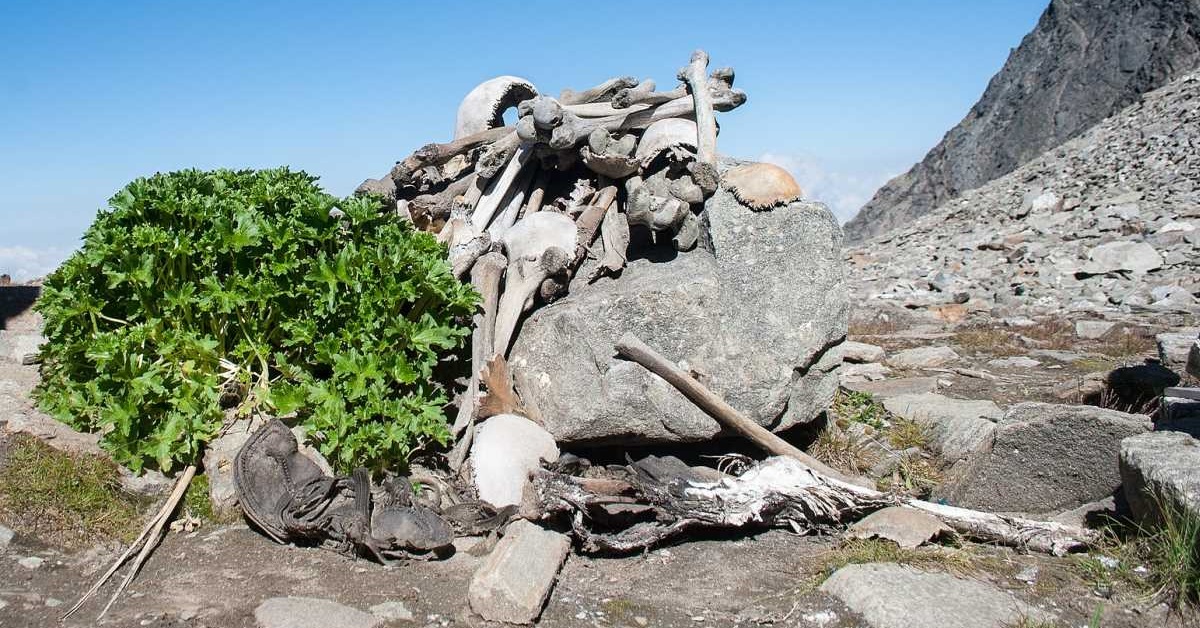Near the eastern border of India, in a remote valley deep in the Himalayas, lies the lake of Roopkund, also known as Skeleton Lake. It didn’t get the name by coincidence – in 1942 a forest ranger was hiking through the Himalayas when he came across the glacial lake. Upon discovery, he was the witness of a grisly spectacle. He saw the skeletal remains of around 500-800 people beneath the clear water of the lake.

Roopkund remains frozen most of the year but during the spring when the snow melts, the bones can be seen floating in the water and lying around the edges of the lake. Some of the bones are so well-preserved that they still have flesh attached to them. Wooden objects, iron spearheads, leather shoes, and rings were also found at the site.
The lake has been puzzling archeologists, anthropologists and other scientists since its discovery in 1942. Many theories have arisen over the years to explain the mystery of the skeletons in the lake.
Since Roopkund was discovered during WW2, the first theory suggested that the bones belonged to Japanese soldiers who were thought to infiltrate British-controlled India. Anyhow, upon examination, it was concluded that the skeletons are way too old to be of Japanese invaders.

Other theories assume the lake was used as a burial ground for people who perished in an epidemic or that a landslide caused the demise of the few hundred souls found at Roopkund, but no evidence ever surfaced that could back these speculations.
A hailstorm has also been named as the key to the mystery. There is a popular folk song among the Himalayan people. It tells the story of a disrespectful group of pilgrims who enraged the Goddess Nanda Devi who created a hailstorm, raining death upon them.
Examination of the skeletons revealed that most of the skulls show the signs of head trauma, caused by a blunt object from above. Therefore, some researchers came to the conclusion that the victims had been really caught in a sudden hailstorm.

However, a study published in 2019 raised new questions and opened the possibility of other explanations. Radiocarbon dating combined with DNA analysis from the bones of 38 individuals found that the remains are from very different eras and belong to three genetically distinct groups. 23 samples originated from present-day India, 1 had south-east Asian ancestry, but most shockingly, 14 had eastern-Mediterranean origins, particularly from Greece.
The international team of archaeologists, geneticists, and other specialists determined that most of the victims indeed passed away around 1000 years ago, but not at the same time. Surprisingly, a few of them died much more recently, likely in the early 19th century.

The fact that some of the bones at Roopkund came from different times and belong to different populations still doesn’t change the fundamental mystery: how the remains of over 500 people ended up at one remote mountain lake at an altitude of 16,470 feet (5,020 m) with no roads or paths leading up to it?

The diversity of the bones suggests that there are probably more events behind the secret of the lake, but there is still no conclusive evidence as to what happened at lake Roopkund and why it had to become the final resting place of more than 500 souls.
Sources: 1, 2, 3
